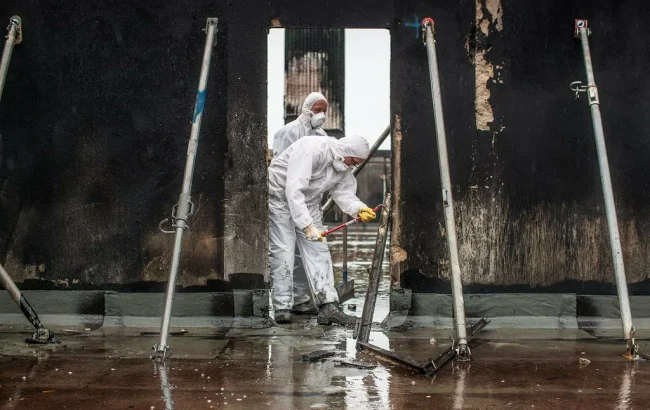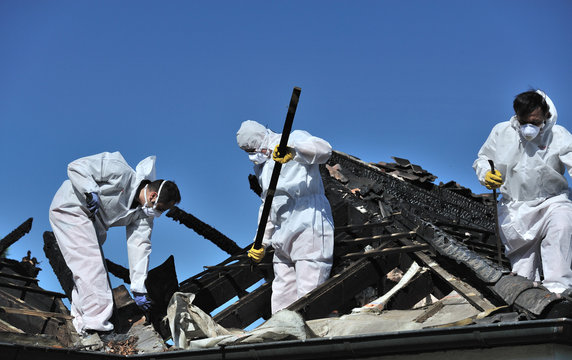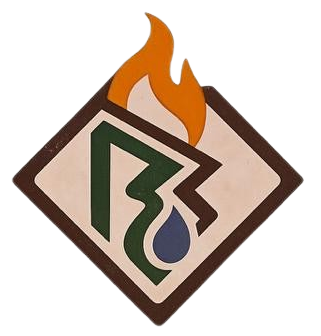How to Remove Mold From Walls
If you’ve spotted those little black, green, or even bluish spots creeping along your walls, you’re probably wondering whether to tackle them now or pretend they don’t exist. Dealing with mold on walls isn’t exactly anyone’s favorite chore, but ignoring it only lets mold spores spread and can make the problem much harder to fix later.
The tricky part is how to get rid of mold on walls permanently. Mold spores are sneaky and can hide behind drywall or under paint. In this blog, we’ll show you how to detect mold inside walls, remove it from different surfaces, and even prevent it from coming back so your home stays healthy and fresh.
Signs of Mold on Walls
Have you ever walked past a wall and caught a smell of something musty, like the basement decided to have its own little swamp? That smell could be a warning sign that mould in house is lurking nearby. How to tell if there is mold behind drywall isn’t always obvious, so knowing what to look for can save you a lot of headaches.
Visible signs are the first clues. Look for black mold, green or blue patches, or discoloration that doesn’t wash away. Water stains, bubbling paint, or warped walls are other signs. But sometimes the mold is hiding, and you might notice subtle hints like allergic reactions in the family, frequent sneezing, or watery eyes when you spend time indoors.
Don’t forget about hidden moisture problems. Leaks and water damage behind walls or ceilings create the perfect environment for mold spores to thrive. Even condensation on windows or damp corners can be enough for mold to sneak in. Staying alert for these signs of mold in drywall or painted surfaces lets you act fast before the infestation grows out of control.
Types of Mold
Not all mold is created equal, and knowing the difference can help you handle it safely. Some are harmless nuisances, while others can be a real threat for your health. Let’s break down the common types you might find on your walls.
Black mold is the one that gives most homeowners nightmares. It loves damp, poorly ventilated areas and can cause serious health effects of mold like asthma flare-ups or sinus problems. At this point, you might be wondering what kills black mold on walls. A bleach solution, carefully applied with a sponge or brush does the job.
White mold is often found in cooler, damp spots like basements or behind cabinets. It can be tricky to locate because it sometimes looks like harmless powdery residue, but it’s still wise to remove it early before it spreads.
Green and blue mold aren’t as scary as black mold, but they’re still a sign of a moisture problem. These colors often appear in bathrooms, around showers, or near windows where there is condensation.
Understanding which type you’re dealing with helps you choose the right mold remover and know whether it’s time for a DIY cleanup or professional mold removal.
Preparing for Mold Removal
Before you roll up your sleeves, it’s important to suit up. Mold may look harmless, but those sneaky mold spores can irritate your lungs, eyes, and skin. Think of it like armor before heading into battle against an invisible enemy.
Start with safety precautions for mold: grab rubber gloves, a mask or respirator, and safety goggles. If you have long sleeves, wear them too. Ventilate the room by opening windows and using fans so any disturbed spores don’t linger.
Next, protect your home. Lay down plastic sheets or old towels to shield floors and furniture from cleaning solutions or falling debris. You can even tape off doorways to prevent spores from traveling to other rooms.
Once you’re fully prepped, you’re ready to dive into DIY mold removal without risking your health or creating a bigger mess.
Tools & Materials Checklist
Here’s what you’ll need before tackling the mold:
- Rubber gloves
- Mask or respirator
- Safety goggles
- Long-sleeve clothing or coveralls
- Plastic sheets or drop cloths
- Painter’s tape
- Old towels
- Spray bottles
- Scrub brushes or sponges
- Buckets for cleaning solutions
- Mold remover spray, bleach, vinegar, or hydrogen peroxide
- HEPA vacuum (optional, for thorough cleanup)
- Dehumidifier (to dry out the area and prevent recurrence)
Removing Mold from Different Wall Surfaces
Not all walls are created equal, which is why the answer to how to remove mold from painted walls isn’t the same as dealing with drywall or concrete. The good news is that with the right approach, you can tackle each surface without damaging it and stop mold from coming back.
Painted Walls
If your walls are painted, surface mold is easy to remove. You can remove mold from walls with vinegar by mixing equal parts vinegar and water or using hydrogen peroxide in a spray bottle. Lightly spritz the affected areas and let it sit for a few minutes. Then, gently scrub with a sponge or soft brush. For stubborn spots, a bleach for mold solution (one part bleach to three parts water) can help, but avoid over-scrubbing to prevent paint damage. Once cleaned, wipe down the wall and allow it to dry completely.
Tip: Ask yourself, “How to remove mould from walls without damaging paint?” The trick is gentle scrubbing, proper ventilation, and giving the wall plenty of time to dry.
Drywall
Removing drywall mold is a bit trickier than painted walls. If you spot signs of mold behind drywall like discoloration, bubbling, or a musty smell, you might need to remove and replace sections of the wall. For small patches, a vinegar or mold remover spray should do the job. For severe infestations, cut out the affected area, dispose of it carefully, and replace with new drywall.
Concrete and Basement Walls
Basements are safe havens for mold growth thanks to moisture and poor ventilation. Scrub walls with a stiff brush using a bleach for mold or borax solution. Rinse thoroughly and dry completely. Once the wall is clean, apply a sealant to help prevent future growth. A dehumidifier is your best friend here if you want to maintain moisture control.
Tile and Grout
Tile walls, especially in bathrooms, can develop stubborn mold in the grout. Baking soda paste or a vinegar solution works wonders here. Apply, scrub with a toothbrush or grout brush, rinse, and dry. Keep your bathroom ventilated to stop mould in house from returning.
When to Call a Professional
Sometimes DIY mold removal is fine, but there are situations where calling in experts is the safer, smarter choice. The reason behind this is that mold can hide in places you cannot see, and certain types, like black mold, can be harmful to health.
Ask yourself questions like: “Can mold inside walls make you sick?” or “How do I tell if there is mold behind drywall?” If the answer is yes, it’s time to consider professional help.
Situations That Require Experts
- Large Infestations: If mold covers more than 10 square feet, tackling it alone can be risky. Professionals have specialized equipment to remove mold spores safely.
- Hidden Mold: Mold inside walls, ceilings, or crawl spaces may go unnoticed but can still affect air quality and structural integrity. A professional mold inspection will uncover it.
- Health Concerns: Persistent allergic reactions, asthma flare-ups, or respiratory issues linked to mold exposure mean it’s safer to call a certified team.
- Post-Water Damage: Floods, roof leaks, or plumbing disasters increase the risk of deep mold infestations. Experts combine water damage restoration with mold remediation services.
- Recurring Mold: If you repeatedly clean the same areas and mould in house keeps coming back, professional remediation ensures it doesn’t return.
Quick Reference Table
| Wall Surface | Best Cleaning Method | Key Tips |
|---|---|---|
| Painted Walls | Vinegar/Hydrogen Peroxide, bleach if needed | Gentle scrubbing, dry completely |
| Drywall | Vinegar/Mold Remover Spray, remove if extensive | Cut out, avoid power saws, dispose safely |
| Concrete/Basement | Bleach/Borax solution, stiff brush | Rinse and dry, seal, use dehumidifier |
| Tile/Grout | Baking soda paste or vinegar | Scrub grout, ventilate area |
Preventing Future Mold Growth


Once you’ve tackled the mold, the last thing you want is to watch it slowly creep back. Prevention is all about controlling moisture, improving airflow, and keeping your walls and surfaces immune to mold spores.
Moisture Control
Mold loves damp environments, so fixing leaks and managing water is important. Inspect your home regularly for plumbing leaks, roof issues, or condensation spots. Dry any wet materials within 24 to 48 hours, because mold spores can start growing quickly on damp surfaces.
Improve Ventilation
Air circulation is equally important. Run exhaust fans in kitchens and bathrooms, open windows when weather allows, and consider using an air conditioner or dehumidifier in humid areas.
Humidity Management
Keep indoor humidity below 50 percent. You can measure this with a hygrometer. If your home is too humid, a dehumidifier or proper ventilation can prevent condensation on walls and ceilings.
Use Mold-Resistant Products
For high-risk areas, like bathrooms or basements, consider mold-resistant paint or waterproof sealants. They add an extra layer of protection against surface mold and help prevent stains after cleaning.
Regular Inspections
Finally, schedule periodic checks in areas prone to dampness, such as basements, laundry rooms, and around plumbing. Catching signs of mold behind drywall early can save you from costly repairs and extensive mold removal later.
Conclusion:
Removing mold on walls might feel overwhelming, but understanding how to detect it, remove it, and prevent it from coming back can make the process much more manageable. Whether you’re tackling surface mold on painted walls or addressing hidden growth behind drywall, taking action early protects both your home and your health.
If tackling mold sounds like too much to handle on your own, Rock Bottom Recovery & Restoration is here to help. Our licensed cleanup experts specialize in Mold Remediation Services, ensuring that mold is removed from your walls permanently and safely.
FAQs
No, mold on walls does not simply disappear. Mold spores thrive in moisture, so unless the source of water or humidity is addressed, mold will continue to grow.
To get rid of mould permanently, eliminate its moisture source by fixing leaks and controlling humidity with a dehumidifier, then clean the affected wall with an antifungal spray or a solution like undiluted white vinegar to kill roots and prevent recurrence.
Use vinegar for porous surfaces and bleach for nonporous surfaces to treat mold, or call a professional for large infestations. Vinegar penetrates and kills mold at its roots on porous materials like drywall, while bleach is effective at killing mold on hard, non-porous surfaces such as tile and glass.
To remove mold from painted walls, wear protective gear, then scrub the mold with a soft brush and a cleaning solution like a 1:10 bleach and water mixture, undiluted white vinegar, or a commercial mold killer.
Yes, mold inside walls can affect your health. Exposure to mold spores can trigger respiratory issues, allergies, sinus problems, and asthma attacks.
